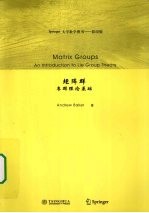

矩阵群 李群理论基础 英文PDF格式文档图书下载
- 购买点数:12 点
- 作 者:AndrewBaker编著
- 出 版 社:北京:清华大学出版社
- 出版年份:2009
- ISBN:9787302214847
- 标注页数:330 页
- PDF页数:346 页
Part Ⅰ.Basic Ideas and Examples 3
1.Real and Complex Matrix Groups 3
1.1 Groups of Matrices 3
1.2 Groups of Matrices as Metric Spaces 5
1.3 Compactness 12
1.4 Matrix Groups 15
1.5 Some Important Examples 18
1.6 Complex Matrices as Real Matrices 29
1.7 Continuous Homomorphisms of Matrix Groups 31
1.8 Matrix Groups for Normed Vector Spaces 33
1.9 Continuous Group Actions 37
2.Exponentials, Differential Equations and One-parameter Sub-groups 45
2.1 The Matrix Exponential and Logarithm 45
2.2 Calculating Exponentials and Jordan Form 51
2.3 Differential Equations in Matrices 55
2.4 One-parameter Subgroups in Matrix Groups 56
2.5 One-parameter Subgroups and Differential Equations 59
3.Tangent Spaces and Lie Algebras 67
3.1 Lie Algebras 67
3.2 Curves,Tangent Spaces and Lie Algebras 71
3.3 The Lie Algebras of Some Matrix Groups 76
3.4 Some Observations on the Exponential Function of a Matrix Group 84
3.5 SO(3) and SU(2) 86
3.6 The Complexification of a Real Lie Algebra 92
4.Algebras,Quaternions and Quaternionic Symplectic Groups 99
4.1 Algebras 99
4.2 Real and Complex Normed Algebras 111
4.3 Linear Algebra over a Division Algebra 113
4.4 The Quaternions 116
4.5 Quaternionic Matrix Groups 120
4.6 Automorphism Groups of Algebras 122
5.Clifford Algebras and Spinor Groups 129
5.1 Real Clifford Algebras 130
5.2 Clifford Groups 139
5.3 Pinor and Spinor Groups 143
5.4 The Centres of Spinor Groups 151
5.5 Finite Subgroups of Spinor Groups 152
6.Lorentz Groups 157
6.1 Lorentz Groups 157
6.2 A Principal Axis Theorem for Lorentz Groups 165
6.3 SL2(C) and the Lorentz Group Lor(3,1) 171
Part Ⅱ.Matrix Groups as Lie Groups 181
7.Lie Groups 181
7.1 Smooth Manifolds 181
7.2 Tangent Spaces and Derivatives 183
7.3 Lie Groups 187
7.4 Some Examples of Lie Groups 189
7.5 Some Useful Formulae in Matrix Groups 193
7.6 Matrix Groups are Lie Groups 199
7.7 Not All Lie Groups are Matrix Groups 203
8.Homogeneous Spaces 211
8.1 Homogeneous Spaces as Manifolds 211
8.2 Homogeneous Spaces as Orbits 215
8.3 Projective Spaces 217
8.4 Grassmannians 222
8.5 The Gram-Schmidt Process 224
8.6 Reduced Echelon Form 226
8.7 Real Inner Products 227
8.8 Symplectic Forms 229
9.Connectivity of Matrix Groups 235
9.1 Connectivity of Manifolds 235
9.2 Examples of Path Connected Matrix Groups 238
9.3 The Path Components of a Lie Group 241
9.4 Another Connectivity Result 244
Part Ⅲ.Compact Connected Lie Groups and their Classification 244
10.Maximal Tori in Compact Connected Lie Groups 251
10.1 Tori 251
10.2 Maximal Tori in Compact Lie Groups 255
10.3 The Normaliser and Weyl Group of a Maximal Torus 259
10.4 The Centre of a Compact Connected Lie Group 263
11.Semi-simple Factorisation 267
11.1 An Invariant Inner Product 267
11.2 The Centre and its Lie Algebra 270
11.3 Lie Ideals and the Adjoint Action 272
11.4 Semi-simple Decompositions 276
11.5 Structure of the Adjoint Representation 278
12.Roots Systems,Weyl Groups and Dynkin Diagrams 289
12.1 Inner Products and Duality 289
12.2 Roots systems and their Weyl groups 291
12.3 Some Examples of Root Systems 293
12.4 The Dynkin Diagram of a Root System 297
12.5 Irreducible Dynkin Diagrams 298
12.6 From Root Systems to Lie Algebras 299
Hints and Solutions to Selected Exercises 303
Bibliography 323
Index 325
- 《矩阵理论和代数基础》 2222
- 《矩阵理论和代数基础》李正良主编 1989
- 《矩阵理论基础》姜家辉编著 1995
- 《控制与信息理论矩阵基础》江崇礼编著 1990
- 《矩阵群 李群理论基础 英文》AndrewBaker编著 2009
- 《矩阵理论》黄廷祝等著 2003
- 《自动控制中的基础数学 线性代数与矩阵理论》王厦生编著 1987
- 《矩阵论基础》周笑明,霍建宇编著 1989
- 《矩阵论学习指导》赵礼峰编著 2016
- 《矩阵函数与矩阵方程》F柏兆俊,高卫国,苏仰锋编 2015
- 《THE GOVERNMENT/PRESS CONNECTION PRESS OFFICERS AND THEIR OFFICES》STEPHEN HESS 1984
- 《PRESS》POLITICS & PUBLIC OPINION IN BIHAR 1912-1947 2010
- 《Press law》Robin Callender Smith. 1978
- 《SUING THE PRESS》RODNEY A.SMOLLA 1986
- 《THE PRESS AND AMERICA》 2222
- 《FREEDOM OF THE PRESS》ERIC BARENDT 2009
- 《FREEDOM OF THE PRESS》ROB EDELMAN 2006
- 《FREEDOM OF THE PRESS》DAVID L.GEBERT 2005
- 《Racism and the press》Teun A.van Dijk 2016
- 《Im spiegel per presse 1》Albert Schmitz 1983
